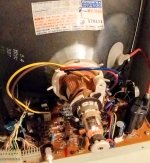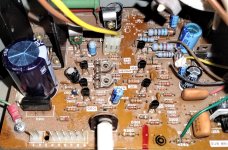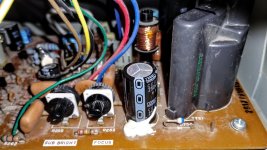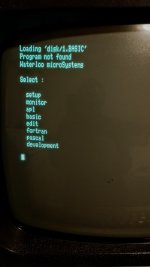The VDU generally connects to the main computer board with a plug. There are a number of wires, some are earth connections, three of them carry the signals Daver2 was talking about.
Obviously for the VDU to work, the three signals have to be present and the VDU powered and working too.
Generally to find where these wire/connections are on the physical plug, people look up the schematic/wiring diagram of their particular computer model on the Zimmers website and the topographical board layout.
When you have found those connections, which you could now call "test points" if you like, you have to assess the signals there, and really they are better examined with a scope so you can see them and check they are correct. The waveforms that should be there are also in the manuals on Zimmers. A meter won't tell you a whole lot, it may give an average indication of the voltage (that depends on the duty cycle of the pulses) but is not that helpful. A logic probe will show there are pulses there, but not if they are correct.
There are literally dozens of different scopes that could be used to view the pulses, both digital and analog types. For scope beginners analog ones are easy to master, you would simply get one that has a 20MHz bandwidth spec or more, use x10 probes to avoid loading the circuit points you are testing and keep the scope on DC coupling unless measuring small noise voltages on lines with a high DC offset.
One thing is for sure, electronic servicing and vintage computer repairs is all about being able to read & follow schematics. This combined with tools for testing circuit points with scopes and understanding the Physics of the components involved, resistors, capacitors, inductors ,diodes transistors and what logic IC's are supposed to be doing from their data sheets & truth tables and the principles of voltage current, & power. Then with the results of testing, formulating a theory on what has gone wrong and testing the theory.
Expecting to be able to repair something complex as a computer at the pcb/component level without this, is like a person thinking they can fly a plane safely without learning the Physics of flight and having many hours or years of training.
Therefore, there is no such thing as a "non-schematics" document or way of repairing electronic faults in vintage computers, unless it is just dumb luck swapping parts, changing pcb's etc in the hope of fixing a problem.
There was a school of thought in the days of TV repairs, that untrained people could fix them, if they carried spare working pcb's in their trucks and just swapped boards out until the TV started working (they got nicknamed Board Jockeys) Of course it resulted in whole boards being replaced where a lot of the time it was only a 50c part on them which had failed.
For those who don't understand or have experience with electronic theory, there can be a tendency for them to over simplify it. For example, many years ago, when I was working in the TV/VDU repair business a friend who was non-technically minded said, "that must be a pretty simple job". I said how do you figure that ? He replied; well don't you just follow the wires and see what's wrong ?




